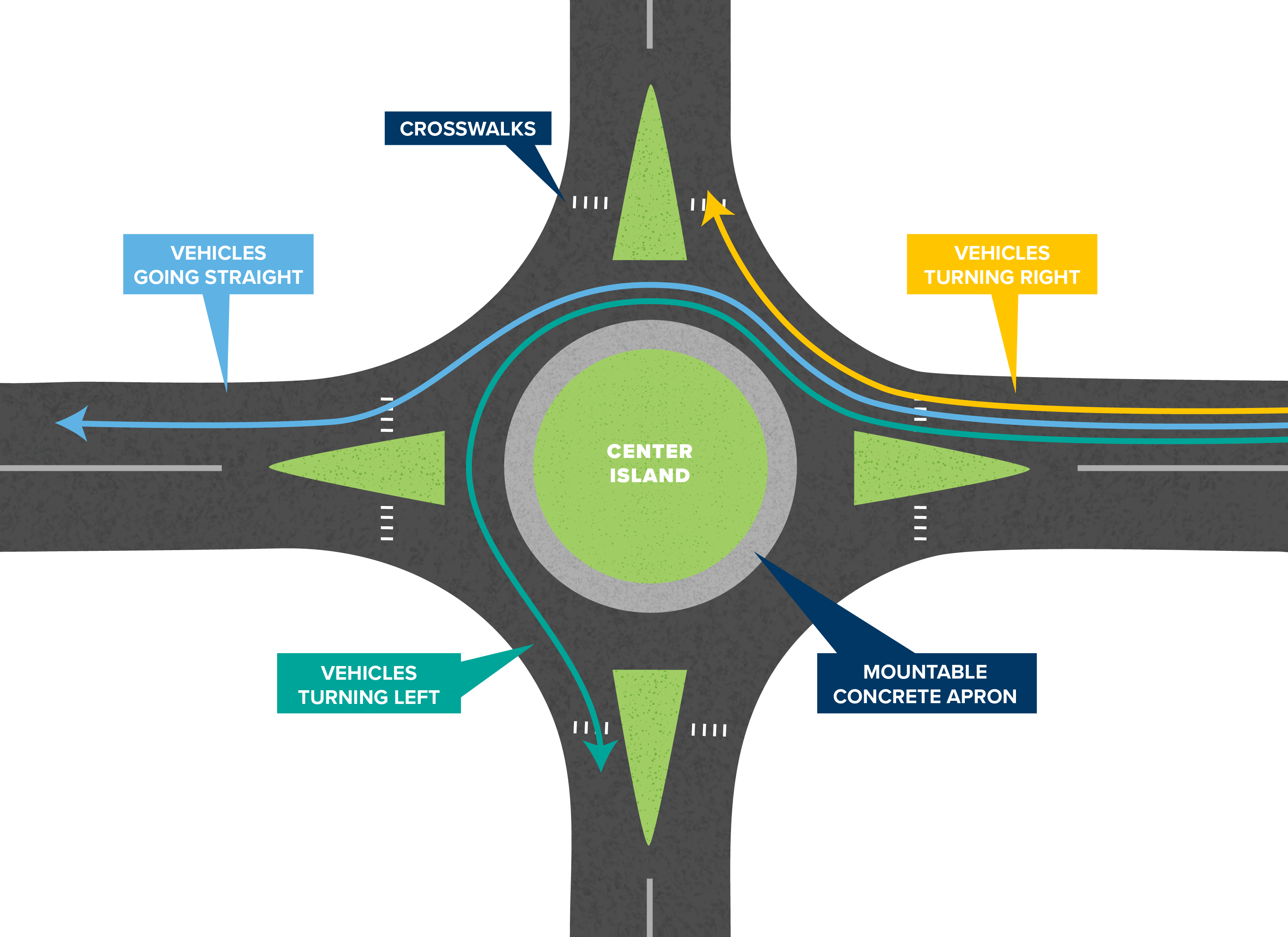ROUNDABOUTS
A roundabout is a one-way circular intersection in which traffic moves counterclockwise around a center island. Roundabouts do not have traffic signals or stop signs, which allows for continuous traffic flow and increased vehicle capacity.
Vehicles entering a roundabout slow down and yield to the vehicles already within the roundabout.
Roundabouts can have one or more lanes, depending on space and the traffic volume needs.
They are designed to accommodate vehicles of all sizes—from small cars to tractor trailers, school buses and boats. Paved concrete aprons within the roundabout allow for large trucks and other vehicles with a wider turn radius to drive over them. Motorists within multi-lane roundabouts should avoid traveling in lanes next to large vehicles to allow for wider turns.

Safety benefits
Crashes at intersections account for about 45% of all crashes nationwide, so enhancing the vehicle flow at these junctures is critical to reducing the risk of overall crashes. Roundabouts are a proven safety countermeasure to accomplish this goal. In communities where roundabouts have replaced traditional intersections, crash statistics show dramatic drops:
-
37 % reduction in all crashes
-
90 % reduction in fatal crashes
-
75 % reduction in injury crashes
-
40 % reduction in pedestrian injuries
When analyzing the performance of 11 new roundabouts in Hardin County since opening between one and three years ago, depending on the intersection, there has been a:
- 31% reduction in total crashes (from 33 per year before construction to 23 per year afterward)
- 81% reduction in injuries (from 6 per year to 1 per year)
- Preliminary monitoring by engineering staff also found a reduction in traffic delays for motorists.
More roundabout benefits
In addition to safety, roundabouts are an effective and beneficial intersection design because they:
-
Save Time by streamlining vehicle movement during peak traffic hours and other times. Because traffic is continuous, drivers experience fewer stops, shorter delays and less congestion.
-
Improve Access to Businesses or Organizations on the opposite side of the road by eliminating risky left turns and prohibiting vehicles from cutting across oncoming traffic. Instead, drivers safely and easily travel counterclockwise in the roundabout, and exit to their destination via a right turn.
-
Reduce Pollution and Fuel Use because drivers make fewer stops followed by hard accelerations and spend less time idling. Motorists aren’t wasting fuel and adding more emissions to the environment like a vehicle stopped at a traffic signal.
-
Save Taxpayer Dollars since there is no traffic signal equipment to install, power and maintain.
-
Promote Community Livability, Beauty, and Comfort by providing quieter corridors, fewer obtrusive traffic signals, and the ability to create a green space in the central island.
How to use a roundabout
Motorists can navigate a roundabout by following four simple steps:
-
Slow Down – As motorists approach a roundabout, they should slow down to the advised speed and prepare to stop if necessary.
-
Be Ready to Yield – Just before entering a roundabout, motorists should watch for – and yield to – pedestrians in the crosswalk or bicyclists. Also, motorists should give the right-of-way to vehicles that are already in the roundabout, approaching from the left.
-
Stay In the Correct Lane – Motorists should get in the appropriate lane well in advance of the intersection. Lane use signs will always show which lanes can be used for different turns.
-
Do not stop within a roundabout – Motorists should not stop, even if they miss their exit. Instead, they should continue around the circle and attempt the intended exit again.
Roundabouts in Kentucky
Graves Road in Boone County
Testimonial
Mt. Sterling Roundabout at KY 686/KY 713 Intersection
A New and Improved KY 351 in Henderson
